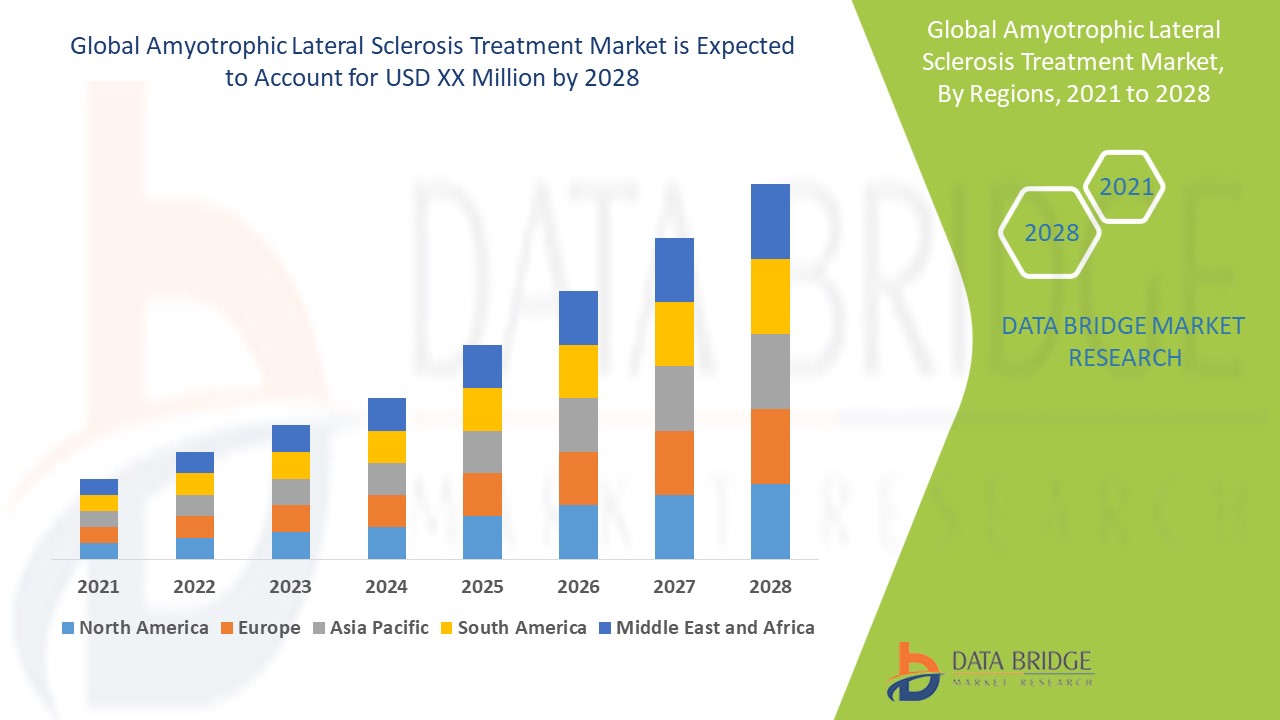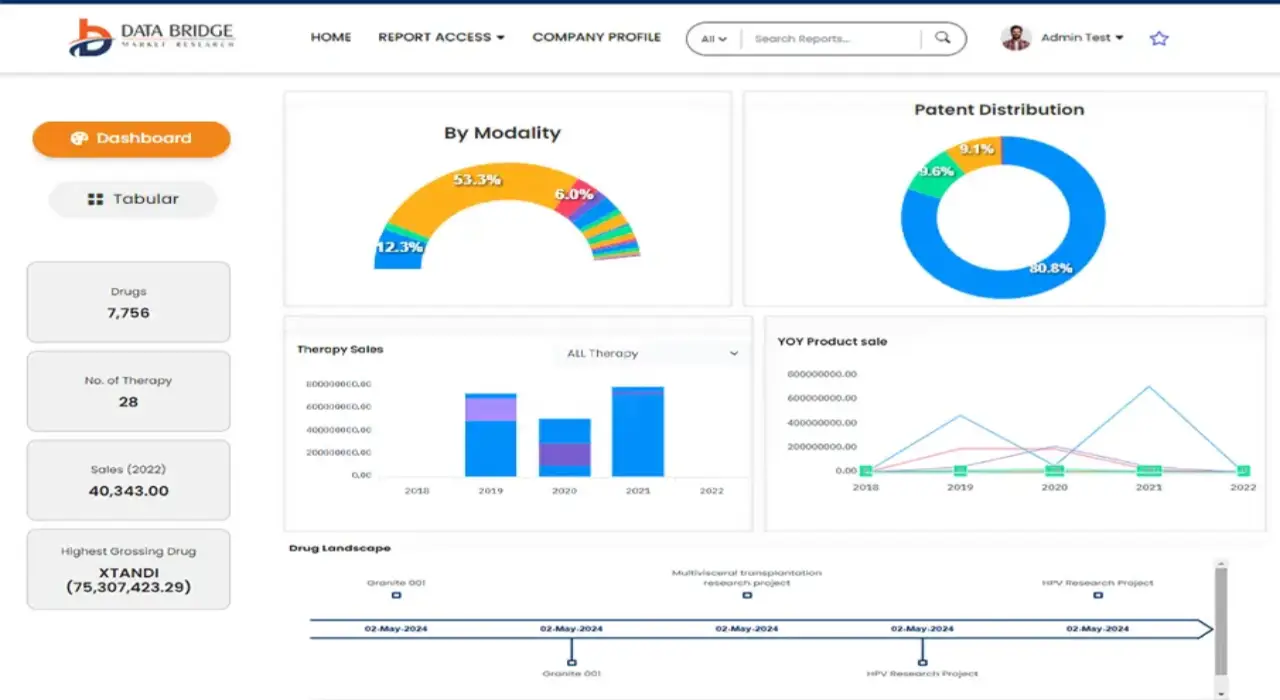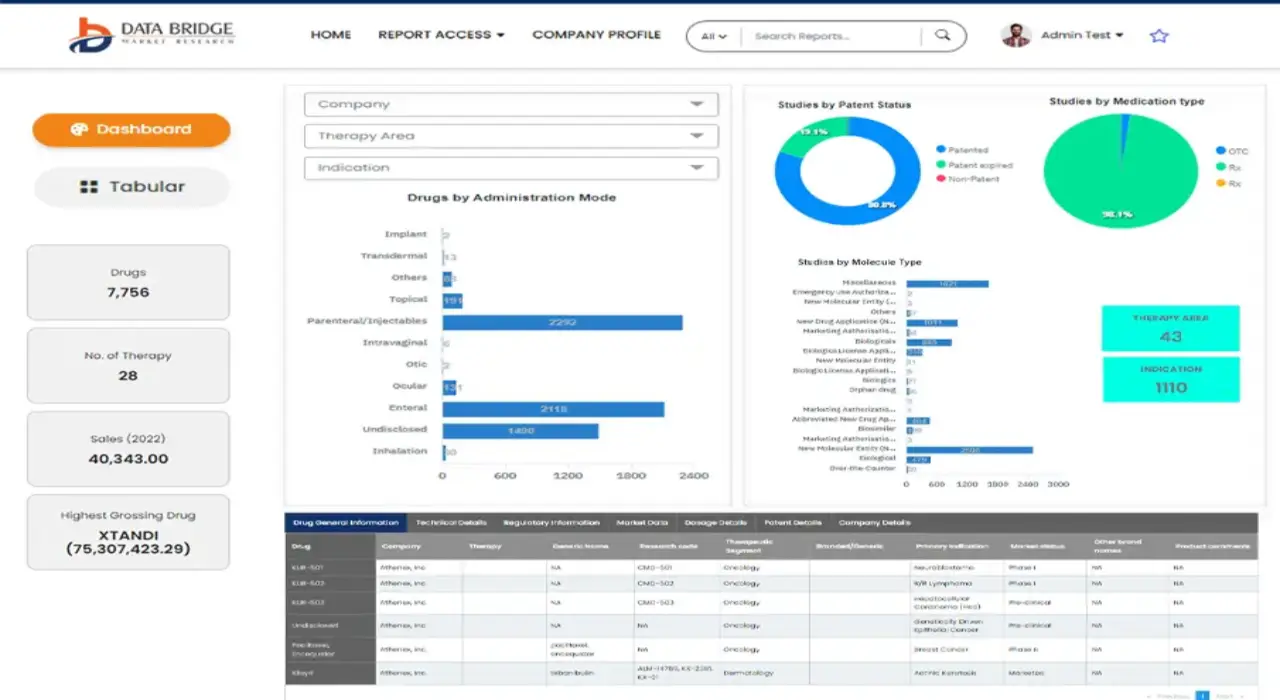Global Amyotrophic Lateral Sclerosis Treatment Market
Market Size in USD Million
CAGR :
% 
 USD
730.03 Million
USD
1,497.88 Million
2024
2032
USD
730.03 Million
USD
1,497.88 Million
2024
2032
| 2025 –2032 | |
| USD 730.03 Million | |
| USD 1,497.88 Million | |
|
|
|
|
Global Amyotrophic Lateral Sclerosis Treatment Market Segmentation, By Type (Sporadic ALS and Familial ALS), Drug Type (Riluzole, Edaravone, and Nuedexta), Treatment Type (Chemotherapy, Medication, Stem Cell Therapy, Physical Therapy, Respiratory Therapy, Speech Therapy, and Others), Distribution Channel (Hospital Pharmacies, Retail and Online Pharmacies), Diagnosis (Laboratory Tests, and Imaging Tests), End User (Hospitals, Research and Academic Institutes, Diagnostic Centers, Specialty Clinics, and Others)– Industry Trends and Forecast to 2032
Amyotrophic Lateral Sclerosis Treatment Market Analysis
The amyotrophic lateral sclerosis (ALS) treatment market has seen significant advancements in recent years, particularly with the development of innovative therapies and improved treatment approaches. Gene therapy is one of the most notable advancements, where treatments such as Tofersen, targeting the SOD1 gene mutation, are being utilized to slow disease progression. Stem cell therapy is another promising treatment avenue, with clinical trials focusing on cellular regeneration to protect neurons and extend motor function.
In addition, monoclonal antibodies such as AMX0035 are designed to target the cellular mechanisms contributing to ALS, showing potential in increasing survival rates and quality of life. There has also been a surge in biomarker discovery, enabling earlier diagnosis and more personalized treatment options.
In terms of growth, the ALS treatment market is expected to grow substantially, driven by these technological innovations and the increased global focus on neurodegenerative diseases. Furthermore, the rise in awareness and advocacy for ALS, along with supportive healthcare policies, is fostering investment in research and expanding the market's reach, benefiting patients worldwide.
Amyotrophic Lateral Sclerosis Treatment Market Size
The global amyotrophic lateral sclerosis treatment market size was valued at USD 730.03 million in 2024 and is projected to reach USD 1,497.88 million by 2032, with a CAGR of 9.40% during the forecast period of 2025 to 2032. In addition to the insights on market scenarios such as market value, growth rate, segmentation, geographical coverage, and major players, the market reports curated by the Data Bridge Market Research also include depth expert analysis, patient epidemiology, pipeline analysis, pricing analysis, and regulatory framework.
Amyotrophic Lateral Sclerosis Treatment Market Trends
“Rising Adoption of Disease-Modifying Therapies (DMTs)”
One specific trend contributing to the growth of the amyotrophic lateral sclerosis (ALS) treatment market is the increasing adoption of disease-modifying therapies (DMTs). Recent advancements in drug development, particularly with the approval of therapies such as Relyvrio by Amylyx Pharmaceuticals and Radicava by Mitsubishi Tanabe Pharma, have brought optimism. These treatments aim to slow the disease's progression, offering hope to patients and their families. As a result, more healthcare providers are adopting these therapies to improve the quality of life for ALS patients. The growing pipeline of promising DMTs and their expanding availability are key factors driving market growth.
Report Scope and Amyotrophic Lateral Sclerosis Treatment Market Segmentation
|
Attributes |
Amyotrophic Lateral Sclerosis Treatment Key Market Insights |
|
Segments Covered |
|
|
Countries Covered |
U.S., Canada and Mexico in North America, Germany, France, U.K., Netherlands, Switzerland, Belgium, Russia, Italy, Spain, Turkey, Rest of Europe in Europe, China, Japan, India, South Korea, Singapore, Malaysia, Australia, Thailand, Indonesia, Philippines, Rest of Asia-Pacific (APAC) in the Asia-Pacific (APAC), Saudi Arabia, U.A.E, South Africa, Egypt, Israel, Rest of Middle East and Africa (MEA) as a part of Middle East and Africa (MEA), Brazil, Argentina and Rest of South America as part of South America |
|
Key Market Players |
Sanofi (France), Mitsubishi Tanabe Pharma Corporation (Japan), BrainStorm Cell Limited (U.S.), Mylan N.V. (U.S.), Sun Pharmaceutical Industries Ltd. (India), Ionis Pharmaceuticals (U.S.), Biogen (U.S.), Covis Pharma (Luxembourg), Apotex Inc. (Canada), Ascend Laboratories LLC (U.S.), ITF Pharma (U.S.), Genervon Biopharmaceuticals, LLC (U.S.), ORPHAZYME A/S (Denmark), Orion Pharma Ltd. (Finland), KRINGLE PHARMA, INC. (U.S.), F. Hoffmann-La Roche Ltd. (Switzerland), Advanz Pharmaceutical (U.K.), Otsuka Pharmaceutical Co., Ltd. (Japan), Bausch Health Companies Inc. (Canada), and Amylyx Pharmaceuticals Inc. (U.S.) |
|
Market Opportunities |
|
|
Value Added Data Infosets |
In addition to the insights on market scenarios such as market value, growth rate, segmentation, geographical coverage, and major players, the market reports curated by the Data Bridge Market Research also include depth expert analysis, patient epidemiology, pipeline analysis, pricing analysis, and regulatory framework. |
Amyotrophic Lateral Sclerosis Treatment Market Definition
Amyotrophic lateral sclerosis (ALS) treatment focuses on managing symptoms and improving quality of life, as there is no cure. Medications such as Riluzole and Edaravone may slow disease progression. Physical therapy helps maintain mobility, while occupational therapy supports daily activities. Speech therapy aids communication, and respiratory care is essential as lung function declines. In advanced stages, feeding tubes or ventilators may be used. Multidisciplinary care teams, including neurologists, physiatrists, and psychologists, provide holistic care. Clinical trials are ongoing, exploring gene therapies, stem cell treatments, and other innovative approaches to find more effective ALS treatments.
Amyotrophic Lateral Sclerosis Treatment Market Dynamics
Drivers
- Increased Focus on Personalized Medicine
Personalized medicine is becoming a key driver in the ALS treatment market. As ALS is better understood at the genetic and molecular levels, therapies are being developed to target specific subtypes of the disease. For instance, the drug Tofersen by Biogen is a prime instance of a personalized treatment designed for patients with genetic mutations in the SOD1 gene, a rare form of ALS. This targeted approach enhances the drug’s effectiveness by focusing on the root cause of the disease in specific patient populations. As personalized treatments gain traction, the market is seeing a rise in tailored therapies, which improves patient outcomes and drives growth in the ALS treatment market.
- Increased FDA Approvals of New Drugs
FDA approvals of new drugs significantly boost confidence in the amyotrophic lateral sclerosis (ALS) treatment market by providing patients with innovative treatment options. For instance, the approval of Relyvrio (sodium phenylbutyrate and taurursodiol) by the FDA in 2022 marked a breakthrough in ALS care, offering a new combination therapy for slowing disease progression. This approval not only expanded the market potential by providing a novel treatment option but also encouraged other pharmaceutical companies to invest in ALS drug development. The availability of FDA-approved treatments such as Relyvrio enhances the overall market by giving patients more choices, improving outcomes, and driving the demand for ALS therapies.
Opportunities
- Advances in Gene Therapy
Advances in gene therapy present a significant opportunity in the ALS treatment market. Gene therapies targeting the underlying genetic causes of ALS, such as mutations in the SOD1 or C9orf72 genes, are showing promising results. Companies such as Biogen and Wave Life Sciences are at the forefront, developing treatments that aim to slow or even halt disease progression. These therapies have the potential to revolutionize the ALS landscape by addressing the root cause rather than just managing symptoms. As research continues and clinical trials progress, the market is expected to see an increase in demand for gene-based treatments, offering patients new hope and expanding the market potential.
- Improvement in Disease Management
Recent improvements in disease management for ALS patients, such as advanced respiratory support, feeding tubes, and physical therapy, are creating significant opportunities in the treatment market. These innovations enhance the quality of life for patients by providing better symptom control, improved mobility, and prolonged survival. As these supportive care options become more effective, they complement ALS therapies, making treatment regimens more holistic and successful. This shift toward comprehensive care not only drives demand for new supportive treatment options but also encourages pharmaceutical companies to invest in therapies that align with these advancements, boosting market growth and offering better outcomes for ALS patients worldwide.
Restraints/Challenges
- High Treatment Costs
High treatment costs represent a significant barrier to the ALS treatment market. ALS therapies, including medications and advanced care options, are often prohibitively expensive, limiting their accessibility, particularly in low-income regions and developing countries. The financial burden faced by patients and healthcare systems creates a substantial challenge, as many cannot afford ongoing treatments, even with insurance. This lack of affordability restricts the patient pool that can benefit from available therapies, stunting market growth. As a result, ALS treatment companies face pressure to balance innovation with cost, while the overall market potential remains constrained by economic factors, further hindering its expansion.
- Lack of Effective Treatment
High treatment costs represent a significant barrier to the ALS treatment market. ALS therapies, including medications and advanced care options, are often prohibitively expensive, limiting their accessibility, particularly in low-income regions and developing countries. The financial burden faced by patients and healthcare systems creates a substantial challenge, as many cannot afford ongoing treatments, even with insurance. This lack of affordability restricts the patient pool that can benefit from available therapies, stunting market growth. As a result, ALS treatment companies face pressure to balance innovation with cost, while the overall market potential remains constrained by economic factors, further hindering its expansion.
This market report provides details of new recent developments, trade regulations, import-export analysis, production analysis, value chain optimization, market share, impact of domestic and localized market players, analyses opportunities in terms of emerging revenue pockets, changes in market regulations, strategic market growth analysis, market size, category market growths, application niches and dominance, product approvals, product launches, geographic expansions, technological innovations in the market. To gain more info on the market contact Data Bridge Market Research for an Analyst Brief, our team will help you take an informed market decision to achieve market growth.
Amyotrophic Lateral Sclerosis Treatment Market Scope
The market is segmented on the basis of type, drug type, treatment type, distribution channel, diagnosis and end user. The growth amongst these segments will help you analyze meagre growth segments in the industries and provide the users with a valuable market overview and market insights to help them make strategic decisions for identifying core market applications.
Type
- Sporadic ALS
- Familial ALS
Drug Type
- Riluzole
- Edaravone
- Nuedexta
Treatment Type
- Chemotherapy
- Medication
- Stem Cell Therapy
- Physical Therapy
- Respiratory Therapy
- Speech Therapy
- Others
Distribution Channel
- Hospital Pharmacies
- Retail
- Online Pharmacies
Diagnosis
- Laboratory Tests
- Imaging Tests
End User
- Hospitals
- Research and Academic Institutes
- Diagnostic Centers
- Specialty Clinics
- Others
Amyotrophic Lateral Sclerosis Treatment Market Regional Analysis
The market is analysed and market size insights and trends are provided by country, type, drug type, treatment type, distribution channel, diagnosis and end user as referenced above.
The countries covered in the market report are U.S., Canada, Mexico in North America, Germany, Sweden, Poland, Denmark, Italy, U.K., France, Spain, Netherland, Belgium, Switzerland, Turkey, Russia, Rest of Europe in Europe, Japan, China, India, South Korea, New Zealand, Vietnam, Australia, Singapore, Malaysia, Thailand, Indonesia, Philippines, Rest of Asia-Pacific (APAC) in Asia-Pacific (APAC), Brazil, Argentina, Rest of South America as a part of South America, U.A.E, Saudi Arabia, Oman, Qatar, Kuwait, South Africa, Rest of Middle East and Africa (MEA) as a part of Middle East and Africa (MEA)
North America is expected to dominate the amyotrophic lateral sclerosis (ALS) treatment market due to a significant increase in awareness and rising prevalence of hypertension, a major risk factor for ALS. With advancements in healthcare, particularly in diagnostic and therapeutic options, North America is seeing more diagnoses and improved treatment pathways. The growing number of specialized clinics and increased government funding for research further contribute to the region's market leadership in ALS treatment.
Asia-Pacific region is expected to expand at a significant growth rate in the amyotrophic lateral sclerosis treatment market during the forecast period. This growth is driven by the rising prevalence of ALS across several countries and rapid advancements in healthcare infrastructure. Countries such as Japan, China, and India are focusing on improving healthcare access, which supports the adoption of new treatments and therapies, further accelerating market expansion in this region.
The country section of the report also provides individual market impacting factors and changes in regulation in the market domestically that impacts the current and future trends of the market. Data points such as down-stream and upstream value chain analysis, technical trends and porter's five forces analysis, case studies are some of the pointers used to forecast the market scenario for individual countries. Also, the presence and availability of global brands and their challenges faced due to large or scarce competition from local and domestic brands, impact of domestic tariffs and trade routes are considered while providing forecast analysis of the country data.
Amyotrophic Lateral Sclerosis Treatment Market Share
The market competitive landscape provides details by competitor. Details included are company overview, company financials, revenue generated, market potential, investment in research and development, new market initiatives, global presence, production sites and facilities, production capacities, company strengths and weaknesses, product launch, product width and breadth, application dominance. The above data points provided are only related to the companies' focus related to market.
Amyotrophic Lateral Sclerosis Treatment Market Leaders Operating in the Market Are:
- Sanofi (France)
- Mitsubishi Tanabe Pharma Corporation (Japan)
- BrainStorm Cell Limited (U.S.)
- Mylan N.V. (U.S.)
- Sun Pharmaceutical Industries Ltd. (India)
- Ionis Pharmaceuticals (U.S.)
- Biogen (U.S.)
- Covis Pharma (Luxembourg)
- Apotex Inc. (Canada)
- Ascend Laboratories LLC (U.S.)
- ITF Pharma (U.S.)
- Genervon Biopharmaceuticals, LLC (U.S.)
- ORPHAZYME A/S (Denmark)
- Orion Pharma Ltd. (Finland)
- KRINGLE PHARMA, INC. (U.S.)
- F. Hoffmann-La Roche Ltd. (Switzerland)
- Advanz Pharmaceutical (U.K.)
- Otsuka Pharmaceutical Co., Ltd. (Japan)
- Bausch Health Companies Inc. (Canada)
- Amylyx Pharmaceuticals Inc. (U.S.)
Latest Developments in Amyotrophic Lateral Sclerosis Treatment Market
- In June 2024, Mitsubishi Tanabe Pharma Corporation transferred its European argatroban business to Ethypharm. This strategic move allows Mitsubishi Tanabe to focus on Radicava, an advanced treatment agent for ALS, and enhance its presence in the European market for rare diseases, particularly in neurodegenerative diseases such as amyotrophic lateral sclerosis (ALS)
- In June 2024, The FDA announced a new funding opportunity under the FDA Rare Neurodegenerative Disease Grant Program. This initiative is designed to support clinical studies and research focused on ALS and other neurodegenerative diseases. It aims to accelerate the development of innovative treatments for these life-altering conditions, benefiting patients and healthcare systems
- In February 2024, Biogen’s QALSODY, a groundbreaking SOD1-ALS therapy, received a positive opinion from the European Medicines Agency’s Committee for Medicinal Products. This regulatory milestone marks a significant step in the approval process for QALSODY, which is designed to treat a specific genetic mutation in ALS patients, offering hope for targeted treatment options
- In April 2023, Biogen’s QALSODY (tofersen), a first-of-its-kind SOD1-ALS therapy, received accelerated approval from the FDA for the treatment of SOD1-ALS. This approval represents a major advancement in ALS treatment, marking QALSODY as the third targeted drug approved for this rare and devastating condition, providing new hope for patients with this specific genetic mutation
- In March 2022, Aquestive Therapeutics entered into a licensing agreement with Haisco Pharmaceutical Group to supply Riluzole oral film in China. This partnership aims to expand the availability of Riluzole, an important drug in managing ALS, to Chinese patients, leveraging Aquestive's innovative oral film technology for better adherence and patient outcomes
- In January 2021, Aquestive Therapeutics signed license and supply agreements with Mitsubishi Tanabe Pharma America to distribute EXSERVAN in the U.S. EXSERVAN, a unique oral film formulation of riluzole, provides an alternative delivery method for ALS patients. This agreement strengthens the accessibility of EXSERVAN and enhances patient adherence to ALS treatment regimens in the U.S.
SKU-
Get online access to the report on the World's First Market Intelligence Cloud
- Interactive Data Analysis Dashboard
- Company Analysis Dashboard for high growth potential opportunities
- Research Analyst Access for customization & queries
- Competitor Analysis with Interactive dashboard
- Latest News, Updates & Trend analysis
- Harness the Power of Benchmark Analysis for Comprehensive Competitor Tracking
Research Methodology
Data collection and base year analysis are done using data collection modules with large sample sizes. The stage includes obtaining market information or related data through various sources and strategies. It includes examining and planning all the data acquired from the past in advance. It likewise envelops the examination of information inconsistencies seen across different information sources. The market data is analysed and estimated using market statistical and coherent models. Also, market share analysis and key trend analysis are the major success factors in the market report. To know more, please request an analyst call or drop down your inquiry.
The key research methodology used by DBMR research team is data triangulation which involves data mining, analysis of the impact of data variables on the market and primary (industry expert) validation. Data models include Vendor Positioning Grid, Market Time Line Analysis, Market Overview and Guide, Company Positioning Grid, Patent Analysis, Pricing Analysis, Company Market Share Analysis, Standards of Measurement, Global versus Regional and Vendor Share Analysis. To know more about the research methodology, drop in an inquiry to speak to our industry experts.
Customization Available
Data Bridge Market Research is a leader in advanced formative research. We take pride in servicing our existing and new customers with data and analysis that match and suits their goal. The report can be customized to include price trend analysis of target brands understanding the market for additional countries (ask for the list of countries), clinical trial results data, literature review, refurbished market and product base analysis. Market analysis of target competitors can be analyzed from technology-based analysis to market portfolio strategies. We can add as many competitors that you require data about in the format and data style you are looking for. Our team of analysts can also provide you data in crude raw excel files pivot tables (Fact book) or can assist you in creating presentations from the data sets available in the report.













